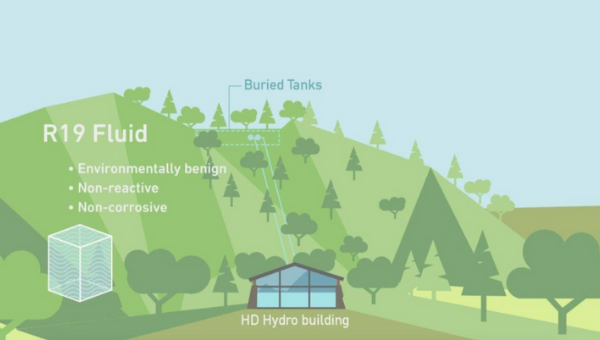
Understanding opportunities and practical examples within the energy storage sector
In at least two-thirds of the world’s countries, solar and onshore wind power are already the cheapest alternative energy sources. Nevertheless, the sun does not always shine, and the wind does not always blow. One of the main drawbacks of renewable energy is its intermittency, and the solution is in energy storage. However, storing energy can have a significant environmental impact, and that’s where RheEnergise comes.
RheEnergise is a start-up that brings a new solution to the renewable energy’s intermittency problem, offering a low-cost, agile and clean energy storage option.
In at least two-thirds of the world’s countries, solar and onshore wind power are already the cheapest alternative energy sources, thus threatening the two fossil-fuel mainstays – coal and natural gas. A decade ago, around $300 and $100 were charged respectively for a megawatt-hour of solar and onshore wind, but things have now changed, with an average price of $35 for both, across diverse countries – Brazil, China and the US. This significant drop in prices is mainly due to the high number of innovations on the horizon, which, day by day, make their appearance on the market.
Nevertheless, the sun does not always shine, and the wind does not always blow. One of the main drawbacks of renewable energy is its intermittency. One problem that arises is the low number of options available for energy storage.
Before getting into detail, an essential introductory remark has to be made. When talking about energy storage, diverse needs can be identified based on the timeframe in which the energy has to be effectively stored and, consecutively, different instruments can be used to satisfy these necessities.
One of the most common storage systems for short-term periods is batteries, more precisely lithium-ion batteries. The use of such resources has increased dramatically in the last decade and has undertaken a tremendous revolutionary pattern. New materials and vanguard technological solutions are being developed, offering a more efficient performance and design-to-recycle approach. An example is the Ultra-Fast Carbon Electrode developed by NAWA Technologies that can increase the battery’s energy storage capability and lifecycle five times. However, among all the advantages brought to the table by these instruments, such as high energy density, low self-discharge rate, and maintenance required, this technology is still considered immature and unsuitable for long-term energy storage. It suffers from many other problems, like high costs, aging, strong protection required – from being overcharged and discharged too fast –, limited means of transport and disposal.
For long-term periods, one of the most efficient systems is represented by dams. They supply the electrical grid with reliability, stability, and sustainability, thus producing a vast volume of electricity with short reaction times without any kind of pollution to the environment. The plants take advantage of the kinetic energy principle through which it produces electricity required during peak hours, more precisely peak consumption hours. In this case, too, the benefits are numerous, like being suitable for industrial applications, cost-effectiveness – even considering high upfronting costs – which is also justified by the fact that its use is designed for an extended period, reaching a life-span of 100 years. On the opposite side, high risks of failure are attributed to dams, causing natural disasters like droughts, loss of wetlands, floods, and damage to the ecosystems. At this point, it would be beneficial to have a few more options to turn to, and something might be in the works.
RheEnergise, a U.K.-based start-up, focuses on an innovative way to supply energy, taking advantage of gravity on hills. It can be compared to existing hydropower plants that bring water up to mountains when energy is inexpensive and then unleash it when required to spin turbines and produce more electricity. The main advantage is that, while a massive dam can take up to a decade or much longer to be constructed, this new scheme can be built between nine and fifteen months. It can be placed on small hills with a range of altitude that ranges from 50 to 299 meters, making it applicable to almost 104,567 sites in Europe, suggesting alternative scopes to ditched land – like abandoned mines that are now fit for new applications. This plant pumps a non-corrosive and non-reactive fluid (R-19) that is two and a half times denser than water, ensuring that it can supply the same volume of energy on a smaller slope. Also, the pipelines through which it is supposed to flow can be positioned underground to not be noticeable in more protected areas.
When comparing this hydro pump plant to dams, the latter might be located in remote places and cause, as previously explained, floods throughout natural areas which might displace not only nature but also people. On the contrary, RheEnergise’s innovative proposition could represent an optimal solution to be harmoniously incorporated in any kind of site without negatively impacting the balance of the ecosystem.
The set-up of the startup’s mechanism is the reproduction of a dam in miniature. Storage tanks are buried at the top and bottom of the hill – which are also connected by underground pipes – and, next to the lower storage tank, a powerhouse is placed, containing all the pumps and turbines.
The firm has initiated a crowdfunding program to fund the next step of its work. Two weeks after it was opened to the public, it earned more than £320,000. The business plans to have its first commercial system in service in 2024. There is still uncertainty regarding structural or environmental risks, so proper preparation and thorough ecological assessment are needed. It is already evident at these initial steps that not every hillside position will be suitable for this purpose.
RheEnergise is one of the many young start-ups becoming game-changers on the market, trying to create a more replicable paradigm to obtain what, for long, seemed just an unattainable goal: the diffusion of renewable energy use at moderate prices.
Although the pandemic has undoubtedly slowed down global development in renewable technology, according to the Renewables 2020 report of the International Energy Agency, electricity-generating technologies have proven remarkably resilient. According to Bloomberg New Energy Finance, which forecasts the industry will be worth more than $620 billion by 2040, the global energy storage market needs to expand to 100 times its current size. Of the world’s energy storage capacity, pumped hydro accounts for around 96%. But as the need for global renewable energy continues to rise, so does the need for more storage projects. Flexible technologies like this one will be part of the smart energy grid, enabling more low-carbon power, heat, and transport technologies.

References:
Eckhouse, B (2020, April 28). Solar and Wind Cheapest Sources of Power in Most of the World | Bloomberg. https://www.bloomberg.com/news/articles/2020-04-28/solar-and-wind-cheapest-sources-of-power-in-most-of-the-world
Enel Green Power (2017). Storage. | Enel Green Power. https://www.enelgreenpower.com/learning-hub/renewable-energies/storage
Hall, Chris (2020, October 6). Future batteries, coming soon: charge in seconds, lasts months and power over the air | Pocket-lint. https://www.pocket-lint.com/gadgets/news/130380-future-batteries-coming-soon-charge-in-seconds-last-months-and-power-over-the-air
Iberdrola (2021). Do you know what pumped-storage hydroelectric power stations are used for? | Iberdrola. https://www.iberdrola.com/environment/pumped-storage-hydropower
IEA (2020). Renewables 2020 – Analysis | IEA. https://www.iea.org/reports/renewables-2020
IRENA (2020). Battery Storage Paves Way for a Renewable-powered Future | IRENA. https://www.irena.org/newsroom/articles/2020/Mar/Battery-storage-paves-way-for-a-renewable-powered-future
McManan-Smith, T (2021, February 8). Power in our hills is waiting to be used | the energyst. https://theenergyst.com/power-in-our-hills-is-waiting-to-be-used/
RheEnergise (2021). Homepage | Rheenergise. https://www.rheenergise.com/
